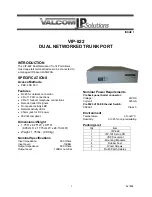
172
Table 57
Configuration items
Item
Description
STP
Select whether to enable STP on the port.
Protection
Set the type of protection to be enabled on the port:
•
Not Set
—No protection is enabled on the port.
•
Edged Port, Root Protection, Loop Protection
—For more information, see
Table 58
.
Instance
(Instance ID,
Port Priority,
Auto Path Cost,
and Manual
Path Cost)
Set the priority and path cost of the port in the current MSTI:
•
Priority
—The priority of a port is an important factor in determining whether the port can
be elected as the root port of a device. If all other conditions are the same, the port with
the highest priority will be elected as the root port. On an MSTP-enabled device, a port
can have different priorities in different MSTIs, and the same port can play different roles
in different MSTIs, so that data of different VLANs can be propagated along different
physical paths, implementing per-VLAN load balancing. You can set port priority values
based on the actual networking requirements.
•
Path cost
—A parameter related to the rate of a port. On an MSTP-enabled device, a port
can have different path costs in different MSTIs. Setting appropriate path costs allows
VLAN traffic flows to be forwarded along different physical links, achieving VLAN-based
load balancing. The device can automatically calculate the default path cost.
Alternatively, you can also manually configure path cost for ports.
Advanced
•
Point to Point
Specify whether the port is connected to a point-to-point link:
{
Auto
—Configure the device to automatically detect whether or not the link type of the
port is point-to-point.
{
Force False
—The link type for the port is not point-to-point link.
{
Force True
—The link type for the port is point-to-point link.
If a port is configured as connecting to a point-to-point link, the setting takes effect for the port
in all MSTIs. If the physical link to which the port connects is not a point-to-point link and you
force it to be a point-to-point link by configuration, the configuration might incur a temporary
loop.
•
Transmit Limit
—Configure the maximum number of MSTP packets that can be sent during
each Hello interval.
The larger the transmit limit is, the more network resources will be occupied. HP
recommends that you use the default value.
•
MSTP Mode
—Set whether the port migrates to the MSTP mode.
In a switched network, if a port on an MSTP (or RSTP) device connects to a device running
STP, this port will automatically migrate to the STP-compatible mode. After the device
running STP is removed, the port on the MSTP (or RSTP) device may not be able to migrate
automatically to the MSTP (or RSTP) mode, but will remain operating in the
STP-compatible mode. You can set this option to enable the port to automatically migrate
to the MSTP (or RSTP) mode.
Select port(s)
Select one or multiple ports on which you want to configure MSTP on the chassis front panel.
If aggregate interfaces are configured on the device, the page displays a list of aggregate
interfaces below the chassis front panel. You can select aggregate interfaces from this list.
Summary of Contents for HP 830 Series
Page 37: ...25 Figure 18 Configuration complete ...
Page 70: ...58 Figure 49 Displaying the rate settings of ports ...
Page 78: ...66 Figure 56 Configuring the monitor port ...
Page 82: ...70 Figure 59 Switching to the management level ...
Page 87: ...75 Figure 64 Displaying port traffic statistics ...
Page 167: ...155 Figure 154 Displaying the current voice VLAN information ...
Page 304: ...292 Figure 280 Traceroute operation result ...
Page 321: ...309 Request timed out Ping statistics for 10 0 0 1 Packets Sent 4 Received 0 Lost 4 100 loss ...
Page 343: ...331 Figure 330 Ping operation summary ...
















































